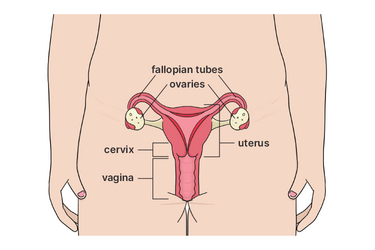On this page, you’ll find information about endometrial hyperplasia, including the symptoms, causes, risk factors and treatments.
What is endometrial hyperplasia?
Symptoms of endometrial hyperplasia
Causes of endometrial hyperplasia
Risk factors for endometrial hyperplasia
How is endometrial hyperplasia diagnosed?
Treatments for endometrial hyperplasia
When to see your doctor about endometrial hyperplasia
Endometrial hyperplasia is a condition where the lining of the uterus (endometrium) becomes thicker than normal.
There are 2 types of endometrial hyperplasia:

Symptoms of endometrial hyperplasia can include:
Endometrial hyperplasia is caused by an abnormal production of oestrogen and progesterone hormones during your menstrual cycle.
In the first part of your menstrual cycle, oestrogen hormones stimulate the lining of your uterus to thicken. After ovulation (mid cycle), your ovary produces oestrogen and progesterone. The progesterone stops the lining of your uterus from getting thicker. If progesterone is not produced, the lining can become abnormally thick, increasing the risk of developing endometrial cancer.
If you don’t ovulate consistently during your menstrual cycles, it can increase the risk for endometrial hyperplasia. This might happen if you have polycystic ovarian syndrome (PCOS) or in the lead-up to menopause (perimenopause).
If you are menopausal and taking menopausal hormone therapy (MHT), your risk for endometrial hyperplasia can increase if you don’t have enough progesterone in your treatment.
There are other risks for endometrial hyperplasia. For example, if you:
If you think you might have endometrial hyperplasia, see your doctor. They will ask about your periods and any abnormal bleeding. They will also ask about pre-existing conditions and possible causes of the bleeding.
Your doctor might do a vaginal examination to look for anything that may be causing abnormal bleeding.
You may also need to get blood tests to see if you have an iron deficiency or anaemia due to the bleeding.
If your doctor thinks you might have endometrial hyperplasia, they will usually recommend an internal ultrasound via the vagina. This will help them assess the size of your uterus and the thickness of your uterus lining. They will also look for endometrial polyps, fibroids and adenomyosis to exclude them as possible causes of the bleeding.
If the uterus lining is thick, your doctor may refer you to a gynaecologist. The gynaecologist will organise for you to have a procedure that allows them to look inside your uterus. The procedure is done via the vagina. Samples are taken and sent for testing in a laboratory to see if you have endometrial hyperplasia.
If you are diagnosed with endometrial hyperplasia, your doctor will talk to you about different treatment options.
Typical endometrial hyperplasia is less likely to progress to endometrial cancer, but it’s important to get treatment and reduce risk factors.
Your doctor may recommend progestogen treatment. For example:
You will need to have progestogen treatment for a minimum of 6 months, until at least 2 biopsies, taken 6 months apart, have been reviewed by your doctor.
If you are diagnosed with atypical endometrial hyperplasia, your doctor will usually recommend a total hysterectomy due to the high cancer risk. This operation is usually performed via keyhole surgery (laparoscopy).
Depending on your stage of life, your doctor may also recommend removal of your fallopian tubes and ovaries to reduce the risk of ovarian cancer. This surgery will result in medically induced menopause.
See your doctor straight away if you have abnormal bleeding. It’s important to rule out all other causes of the bleeding and, if diagnosed with endometrial hyperplasia, treat it as early as possible.
This content has been reviewed by a group of medical subject matter experts, in accordance with Jean Hailes policy.
© Jean Hailes Foundation. All rights reserved.